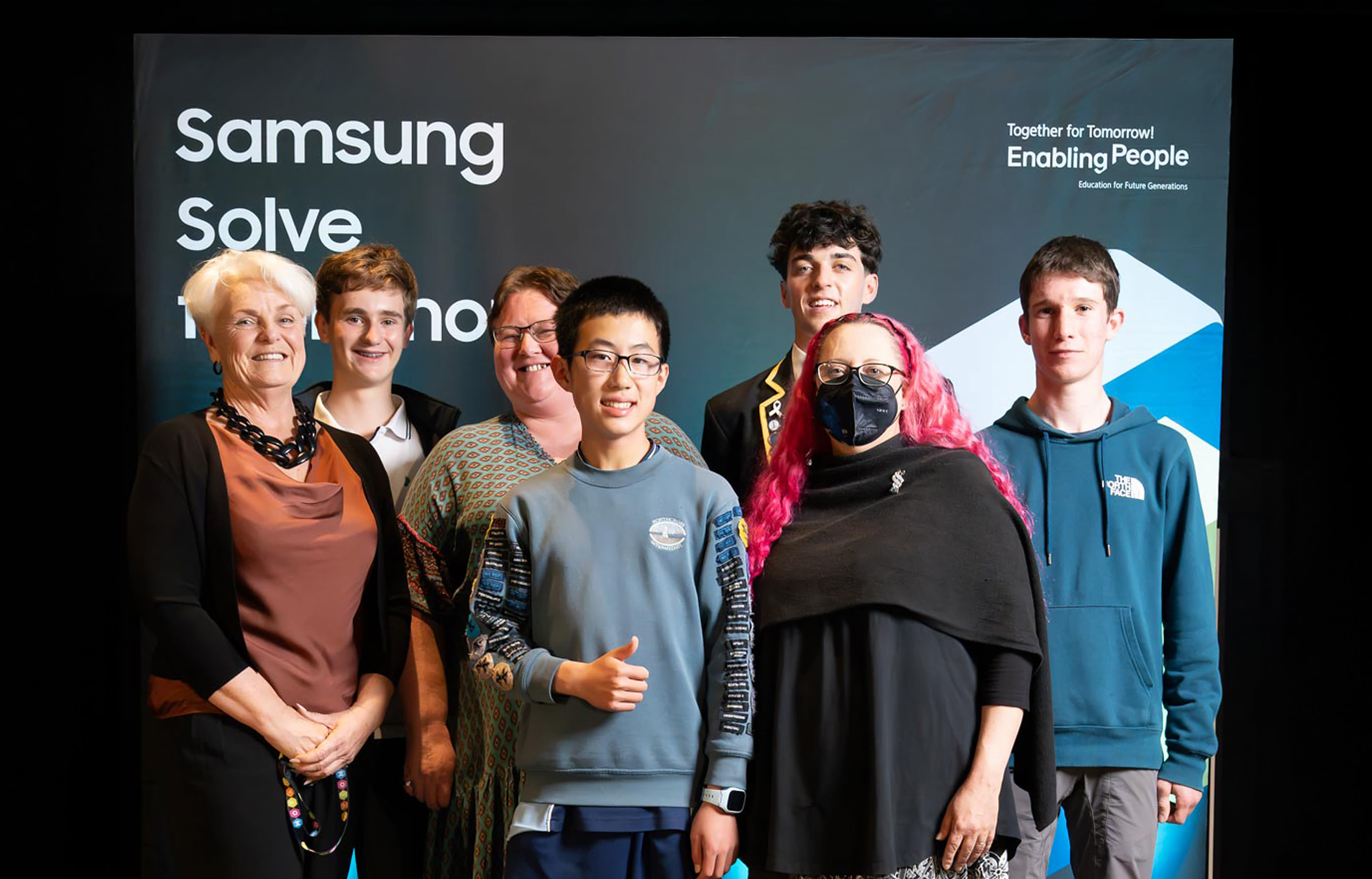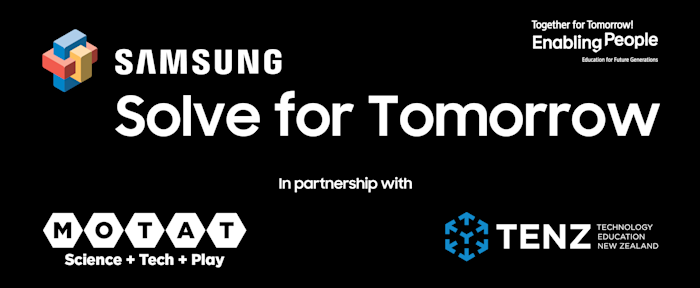INNOVATION AND CREATIVITY ON DISPLAY AS SAMSUNG CROWNS SOLVE FOR TOMORROW WINNERS


NEW ZEALAND – 31 October 2025
INNOVATION AND CREATIVITY ON DISPLAY AS SAMSUNG CROWNS SOLVE FOR TOMORROW WINNERS
Kiwi students have once again showcased their innovation, with Samsung announcing the Solve for Tomorrow 2025 champions last night. Themes of safety, health, accessibility and AI innovation stood out strongly among the finalists and across the competition as a whole.
Solve for Tomorrow is a nationwide competition, run in partnership with the Museum of Transport and Technology (MOTAT) and Technology Education New Zealand (TENZ). It challenges New Zealand’s next generation of innovators to harness their creativity, and apply design and STEAM (science, technology, engineering, arts, and mathematics) thinking to develop solutions that make a positive difference in their communities and contribute to a brighter future for Aotearoa.
Entries were assessed by an expert judging panel of Dr. Joel Rindelaub, Dr Siouxsie Wiles, MOTAT’s Head of Education, Julie Baker, and Ruth Lemon, Kaiārahi of TENZ.
Now in its fifth year, Solve for Tomorrow continues to celebrate the ingenuity of Aotearoa’s young innovators. For 2025, the competition introduces an updated prize allocation that also recognises the vital role teachers play in inspiring and supporting their students, with teachers of winning entries each receiving $1,000 from the prize pool.
First place in the year 7-10 category was awarded to Jack Harker from ACG Parnell College in Auckland. He developed a low cost live race tracking system for youth sailing. The system uses long range radio devices and a web dashboard so coaches can replay races for analysis and spectators can follow fleets in real time.
"Jack’s project really stood out because he had a clear problem he wanted to solve, and came up with a working solution. By combining low-cost GPS technology and a cloud dashboard, he has created an affordable, scalable way for coaches to offer deeper learning experiences, and for families to follow races in real time. He did the legwork with stakeholders and field trials, and in a nation obsessed with sailing, the prototype already delivers real value for youth programmes," says Dr Siouxsie Wiles.
First place in the year 11-13 category was awarded to Cameron Moore from Rotorua Lakes High School. His Air Brace prototype is an inflatable neck brace for mountain biking. It uses motion detection to deploy only in a crash, limiting neck movement to help prevent serious spinal injury while remaining comfortable to wear. Cameron is the first double winner in the competition, having taken out the junior category two years ago.
"Cameron’s Air Brace tackles a big safety issue in a simple way. It senses a crash and quickly inflates to hold the neck steady, while staying comfortable to wear. As he focuses on speeding up the reaction time and refining how quickly the device inflates, this has real potential to reduce severe neck injuries in mountain biking and other high risk sports," says Dr Joel Rindelaub.
Second place in the year 7-10 category was awarded to Luke Huang from Northcross Intermediate School in Auckland. His Smart Sort scanner uses invisible light to check what kind of plastic an item is and tells people if it’s recyclable or not, helping cut contamination and keep more plastics out of landfill.
Second place in the year 11-13 category was awarded to Jesse Rumball Smith from Wellington College. His Building a Better Backseat Driver project turns a smartphone into an AI co pilot that detects hazards and driver fatigue. This prototype uses computer vision and audio to make road safety more accessible.
Highly commended in the year 7-10 category was awarded to Gabriel Anthony from Whitby Collegiate in Wellington. His Pill AI app uses trusted New Zealand medicine information along with reminders, voice input and language translation to help people take the right medication the right way at the right time. Gabriel’s entry this year was inspired by his winning entry ‘Pill Bot’ in last year’s competition.
This year’s competition highlighted the depth of talent among Aotearoa’s students, with entries showcasing strong skills in STEAM and design thinking. The high calibre of entries across both age categories made the judging process especially difficult.
“Solve for Tomorrow showcases the incredible creativity and problem-solving spirit of our tamariki and rangatahi. It’s inspiring to see the next generation using STEAM to shape a smarter, more sustainable future for Aotearoa,” says Simon Smith, Head of Brand Marketing at Samsung New Zealand.
“Every year we’re amazed by the ideas and energy the Solve for Tomorrow entrants bring, and we can’t wait to see how they continue to make a real difference in their communities.”
Over the past five years Solve For Tomorrow has engaged thousands of students through the competition and Samsung’s sponsorship of MOTAT’s STEAM Cell trailers.
The 2025 winners were celebrated at an event at MOTAT last night, joined by their families and the judging panel. Each winning team receives a share of the $24,000 cash prize pool, including the latest Samsung technology for students, their teachers, and their schools.
About Samsung Solve for Tomorrow
Delivered in partnership with the Museum of Transport and Technology (MOTAT), the Solve for Tomorrow
competition is designed to build interest and proficiency in STEAM (science, technology, engineering, arts, and mathematics). The nationwide competition tasks students in years 7-13 to identify and create a solution for an issue important to them and their community, which are then judged on creativity and originality, relevance to the community, feasibility of the solution, presentation, and application of STEAM. This is Samsung Solve for Tomorrow’s fifth year in New Zealand. Launched in the US in 2010, the competition has been hugely influential internationally, with more than 1.7 million students and teachers participating across 20 countries. Read more about the competition here.
About Samsung Electronics Co., Ltd.
Samsung inspires the world and shapes the future with transformative ideas and technologies. The company is redefining the worlds of TVs, smartphones, wearable devices, tablets, digital appliances, network systems, and memory, system LSI, foundry and LED solutions. For the latest news, please visit the Samsung Newsroom here.
About the Museum of Transport and Technology (MOTAT)
MOTAT seeks to use the past, present and future technology and ingenuity of Aotearoa to educate and inspire the innovators of tomorrow. MOTAT provides diverse learning opportunities through education programmes at its museum and STEAM Cells programmes out in schools. As the science and technology playground of Aotearoa, MOTAT is the place to experience interactive learning, fun and exploration through its exhibitions, events and education. Visit MOTAT.NZ
For more information, please contact:
Simon Smith, Samsung Electronics Co., Ltd.
+64 27 667 6664
simon.smith@samsung.com
Ema Lees, Acumen on behalf of Samsung
+642108362145
elees@acumennz.com
Samantha Perry, MOTAT
+64 21 680 335
Samantha.Perry@motat.org.nz



